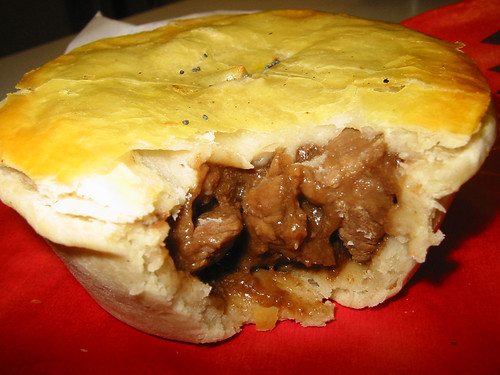
There was a similar finding reported 18 months ago. Pesky that Australians are exceptionally long-lived despite the typical Australian diet being just about everything the food-freaks deplore. There are certainly a lot of nonagenarians about in Australia who grew up on food fried in dripping (animal fat) -- fried steak particularly. Fried steak and eggs was a routine breakfast for many Australian working men up until a few decades ago. And they would only have eaten nuts at Christmas. And to this day, very fatty meat pies (see pic above) and sausage rolls are a great favourite.
Going by the results of double-blind studies (e.g here), however, it is doubtful that type of diet has ANY influence on longevity. The fact that two long-lived populations -- Australians and Japanese -- have radically different diets also supports that conclusion.
The explanations for Australian lifespans given in the news report below are entirely speculative. An equally plausible explanation is that traditional Australian skepticism causes most Australians to ignore food freaks.
The only thing about diet that increases lifespan is restricted calorie intake. Which is probably why the Japanese -- who had very little food for much of the 20th century -- live so long. Restricted calorie intake also stunts growth -- which would also explain why older Japanese are so short. So attributing the high Japanese lifespan to a "healthy" diet is also just a guess that fails to consider other possibilities
Australians are living longer than ever as death rates from the big killers of heart disease and cancer fall and smoking continues to wane in popularity. The Australia's Health 2008 report, released yesterday, shows Australians can now expect to live for 81.4 years - and that we have leap-frogged Sweden and Iceland to claim the No2 spot on the world's life expectancy tables, second only to Japan.
Overall, the latest snapshot of the nation's health paints a mixed picture, showing that while Australians are cutting down on smoking and doing better against cancer and heart disease, we are also fatter, boozier, more likely to catch a sexually transmitted infection, and still likely to end up in hospital for something that could have been avoided.
In 2005-06, more than 9 per cent of hospital admissions were considered potentially preventable. We also too rarely make the diet and lifestyle choices that would ward off diabetes, high blood pressure and other problems, and there are poorer outcomes for people of lower socio-economic status which happens worldwide]. While asthma has receded as a health threat, others such as oesophageal disease, are looming larger.
And the picture for indigenous Australians is also mixed: the gap in death rates between indigenous and non-indigenous Australians appears to be narrowing, but otherwise indigenous adults seem to be slipping even further behind the health of their non-indigenous countrymen. [If you saw the way blacks often live, you would not be surprised. Methanol ("metho") is not a healthy drink]
Launching the report in Canberra yesterday, Health Minister Nicola Roxon said it was a "great achievement" that "highlights both the good and the bad". "We can take heart that an Australian born between 2003 and 2005 can now expect to live 42 per cent longer than those born in 1901-10," Ms Roxon said. "That's an extra 25 years for most people." Once the danger years of youth and middle age are past, men who reach 65 can expect to live to 83, and women to 86 - about six years more than a century ago.
The AIHW said one of the biggest factors in extending life was the drop in smoking rates. About one in six Australians were daily smokers last year, one of the lowest rates in the world. Vaccination also continues to enjoy widespread support, with more than 90 per cent of children fully immunised against the major preventable diseases such as whooping cough, measles and mumps.
As well as asthma affecting an estimated 10.3 per cent of the population in 2004-05 - down from 11.6 per cent in 2001 - other good news is that illicit drug use appears to be falling. The percentage of people aged 14 and over who admitted to using marijuana fell from a high of 17.9 per cent in 1998 to 9.1 per cent last year, while those using methamphetamine or "ice" fell from 3.7 per cent in 1998 to 2.3 per cent last year.
Ecstasy use remained level and only cocaine showed any upward trend, being used by 1.6 per cent of respondents to last year's survey, compared with 1 per cent in 2004.
However, AIHW director Penny Allbon said Australia could do more to tackle the main risk factors for chronic diseases. "In rank order, the greatest improvements can be achieved through reductions in tobacco smoking, high blood pressure, overweight and obesity, physical inactivity, high blood cholesterol and excessive alcohol consumption," Dr Allbon said. "The prevalence of diabetes, which is strongly related to these risk factors, has doubled in the past two decades.
"Excessive alcohol consumption not only brings costs in terms of personal health, but tangible social costs in terms of lost productivity, healthcare costs, road accident costs and crime-related costs that have been estimated at $10.8 billion in 2004-05."
The report shows that alcohol caused 3.8 per cent of the burden of disease for males, and 0.7 per cent for females. Four in five Australians aged 14 and over drank alcohol, and one in 10 did so daily. However, the report said these rates "have been fairly stable since 1993".
Source
Posted by John Ray. For a daily critique of Leftist activities, see DISSECTING LEFTISM. For a daily survey of Australian politics, see AUSTRALIAN POLITICS Also, don't forget your roundup of Obama news and commentary at OBAMA WATCH

Hey JR -
ReplyDeleteI am a bit confused by that picture you put up: is that something you aussies eat? or is it part of an australians intestine?